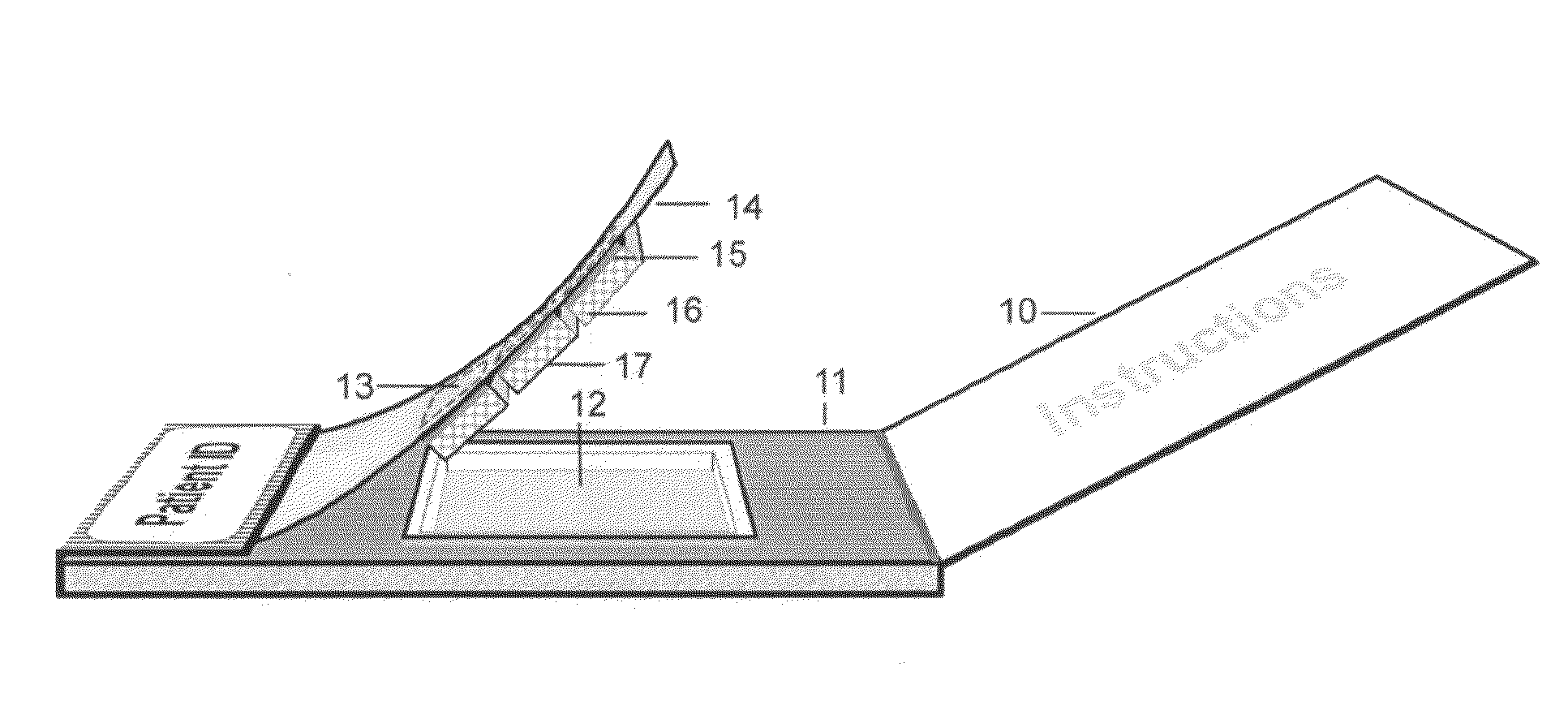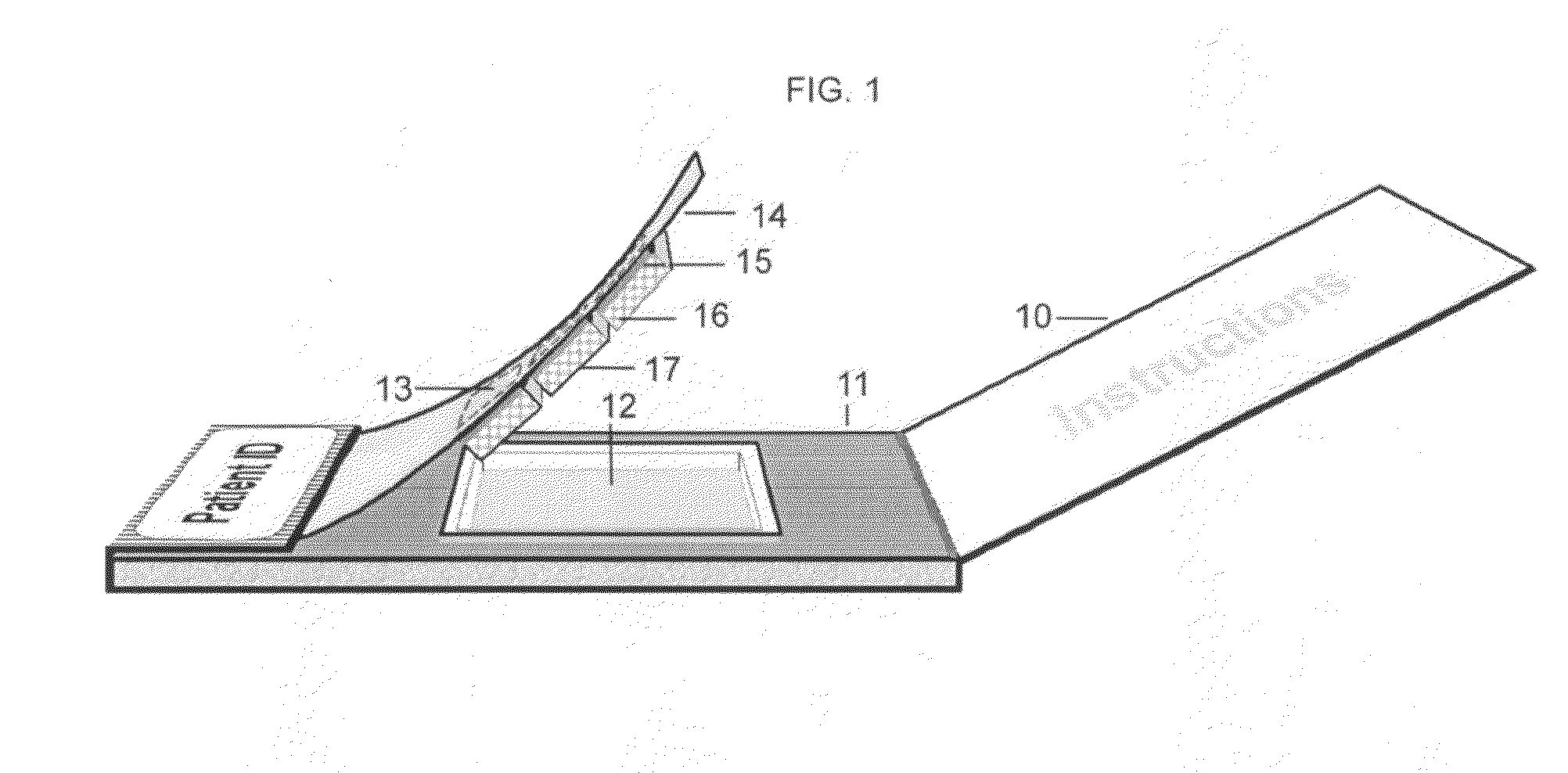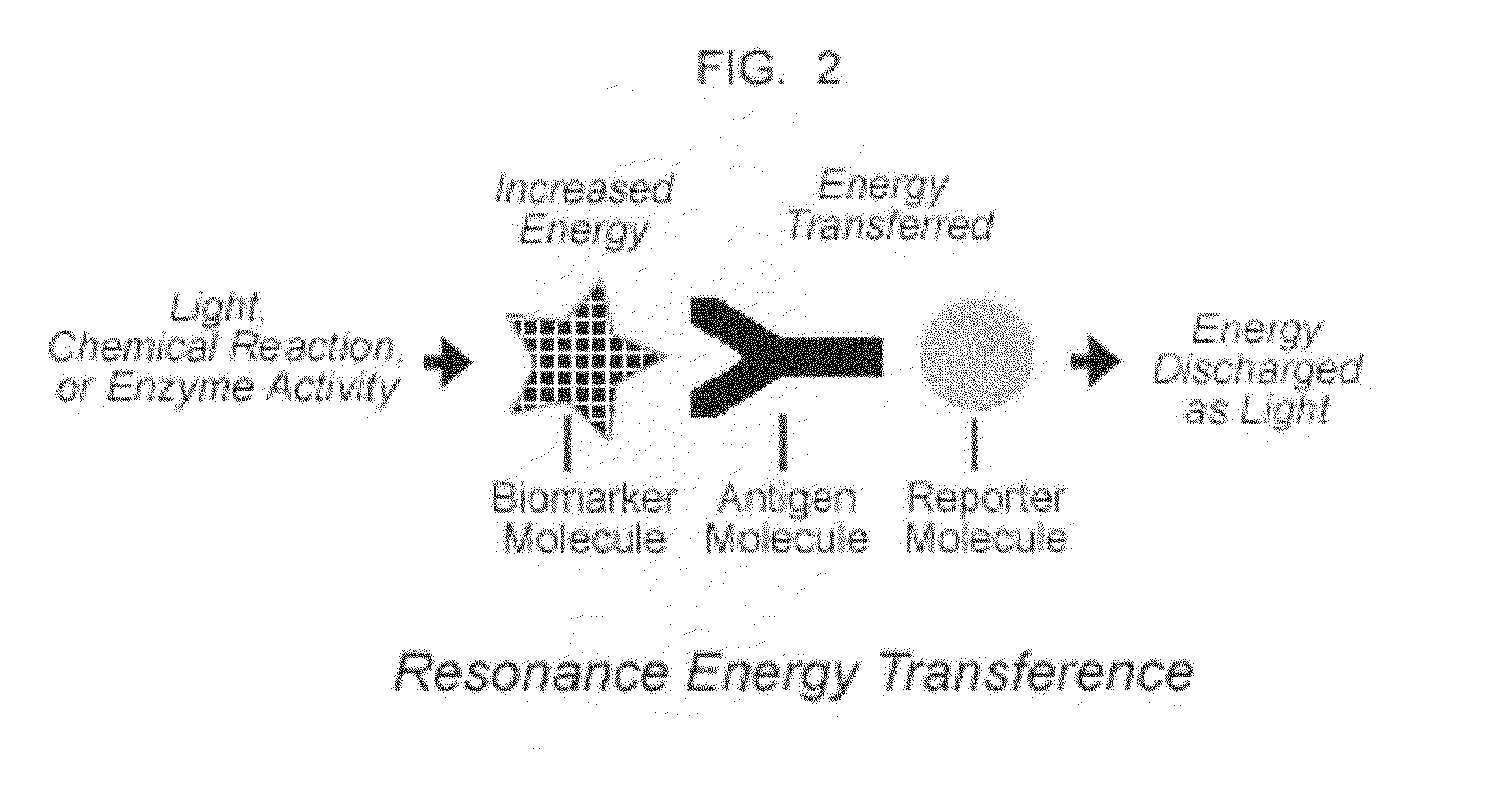(a) Canadian Patent No. 2,558,666 shows a method for detecting biomarkers in saliva, employing high-density
oligonucleotide microassay in a laboratory setting. In particular, the method addresses the detection of
oral cavity and Oropharyngeal squamous
cell carcinoma. U.S. Pat. No. 6,670,141 shows a method for detecting the presence of a panel of salivary biomarkers statistically indicative of
breast cancer in women. The test is performed in a lab. U.S. Pat. No. 6,102,872 shows a method for determining the subject's blood glucose level—a
primary indicator in the management of diabetes. The measurement is made by performing a chemical analysis of the glucose level in the subject's saliva. U.S. Pat. No. 5,914,271 shows a method for determining the fertile period in a female by monitoring the
calcium and
magnesium concentrations present in saliva during the three-to-five day period immediately prior to
ovulation. Standard laboratory analysis of the saliva is implied.
(b) In one method, a
normal laboratory analysis of the saliva in a
reagent changes the color of the
reagent: U.S. Pat. No. 5,858,796 shows a method for analyzing saliva in a
reagent containing FE3+,
chloride ions and multi-atom
alcohol. The process indicates the presence of diabetes, disorders of the
pancreas, initial stages of hypertonic
disease, and hypertension by color change in the reagent itself. A reference chart of colors and the conditions they indicate is part of the method.
(c) In one method, the presence of an infectious
disease is reliably detected through spectrophotometric or chemical analysis: U.S. Pat. No. 5,686,237 shows a method of detecting the presence of infectious and non-infectious agents from an analysis of biomarkers in human and animal saliva. The method uses incubation combined with analysis to determine
exposure to pesticides and hazardous agents, and then compares the observed levels to
baseline data for relevant controlled populations.
(d) At least one method uses an image of the
crystal structure of dried saliva to detect the presence of a specific condition: U.S. Pat. No. 5,572,370 shows a method of detecting the fertile period for a woman by examining the
crystal structure of saliva on a slide. The method employs equipment for depositing saliva on a slide, and then, after the saliva has dried and crystallized, magnifying the image and comparing it to known
crystal structures that are indicative of
fertility.
(e) Several methods have been developed to identify diseases by conjugating laboratory-developed antigens to biomarkers found in saliva that have a known correlation to the existence of those conditions: U.S. Pat. No. 5,695,930 shows a
solid phase
immunoassay method for detecting HIV antibodies in saliva. The method includes causing the HIV P17
protein antigen in saliva to conjugate with an
antibody, which in turn conjugates to a reporter molecule, with the result that there is a color change in the liquid reactants. U.S. Pat. No. 5,792,605 shows a method for detecting the
Hepatitis A
virus in saliva with 99% sensitivity using an
ELISA assay. Both patents require filtering and washing of the
saliva sample using traditional laboratory equipment.
Although this research continues to demonstrate the reliability of saliva as an indicator of
disease, disorders and health conditions, most current methods employ laboratory procedures which would be impossible to replicate in the field or in the privacy of the home.
(i) Access to saliva is not always easy.
Patients may be unable to produce saliva, or for personal reasons may be unwilling or unable to spit.
(ii) The volume of saliva gathered may not be sufficient to support the traditional laboratory analysis, or the
analyte may be too diluted to be detected.
(iii)
Saliva may contain
particulates, large molecules, and proteins that impede collection and interfere with analysis.
(iv) The saliva itself may be contagious and present a danger to others, including the health workers.
Current saliva diagnostic procedures usually require that the sample be flown to a laboratory, with the associated risk of loss of
confidentiality, sample degradation and mix-up.
Results are often not available for days.
As a result, in
spite of its promise as a diagnostic medium, saliva is difficult to analyze in those settings where immediate diagnosis is most crucial, such as in a rural health survey, an epidemic, a
medical emergency, or in the midst of a chemical or biological
attack.
In the case of contagious diseases, for example, the opportunity to identify,
quarantine and treat the infectious person or animal immediately is lost because of the days consumed in laboratory
processing.
In the case of routine
health maintenance functions such as testing for
blood sugar,
pregnancy, HIV / AIDS, or medication levels, saliva offers a reliable, real time, non-invasive indicator, but the equipment and skills required to complete the prevalent analysis are beyond the reach of the normal person.
None of these devices and methods for analyzing saliva address the problem of timeliness.
It also means that antivirals, which could be very effective at the onset of the disease, may be too late by the time the normal diagnosis is confirmed.
Nor do the solutions already proposed address the problem of handling contagious material.
Most of the current procedures for collecting and analyzing saliva involve transportation and handling of the saliva by multiple health workers, using expensive laboratory analysis that would not normally be possible in the poor and densely populated areas where infections like HIV / AIDS,
Hepatitis,
Tuberculosis and the flu spread most rapidly.
While solutions have been offered that use the
immunoassay process to bind antigens to biomarkers of various diseases, they still rely on
time consuming laboratory processes to determine the results of the diagnosis.
While each of these patents extends the
chromogenic tools available in a laboratory, none incorporate a device and method for performing such
chromogenic diagnostics in the field where the detection of disease could have the greatest
impact.
 Login to View More
Login to View More  Login to View More
Login to View More 


